display Alfa Romeo 8C 2007 Owner handbook (in English)
[x] Cancel search | Manufacturer: ALFA ROMEO, Model Year: 2007, Model line: 8C, Model: Alfa Romeo 8C 2007Pages: 223, PDF Size: 14.35 MB
Page 61 of 223
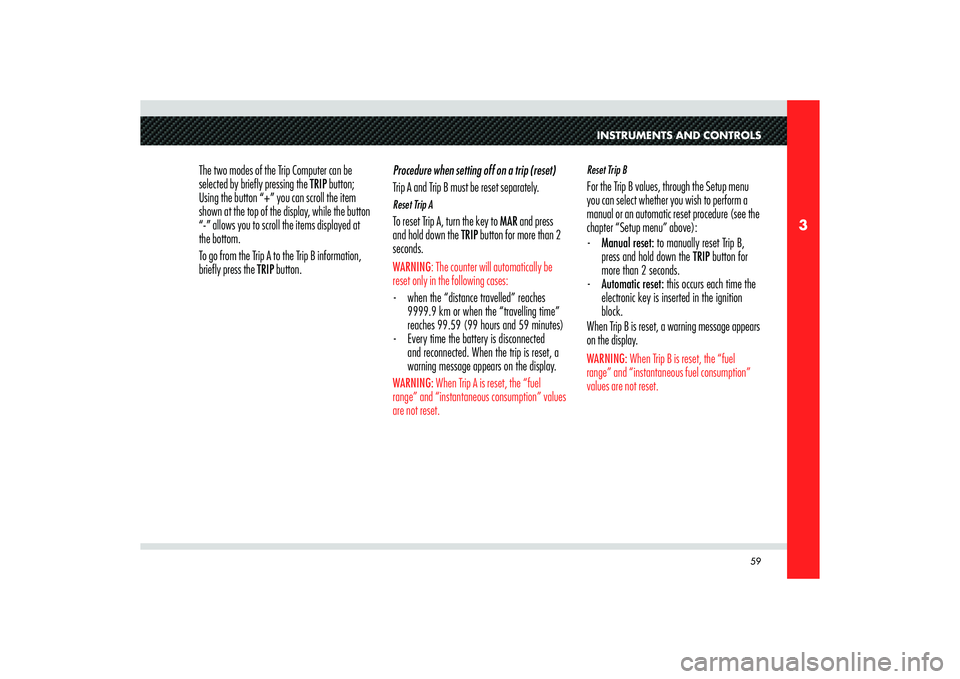
59
3
INSTRUMENTS AND CONTROLS
The two modes of the Trip Computer can be
selected by briefly pressing the TRIP button;
Using the button “+” you can scroll the item
shown at the top of the display, while the button
“-” allows you to scroll the items displayed at
the bottom.
To go from the Trip A to the Trip B information,
briefly press the TRIP button.Procedure when setting off on a trip (reset)
Trip A and Trip B must be reset separately.
Reset Trip ATo reset Trip A, turn the key to MAR and press
and hold down the TRIP button for more than 2
seconds. WARNING: The counter will automatically be
reset only in the following cases:- when the “distance travelled” reaches
9999.9 km or when the “travelling time”
reaches 99.59 (99 hours and 59 minutes)
- Every time the battery is disconnected
and reconnected. When the trip is reset, a
warning message appears on the display.WARNING: When Trip A is reset, the “fuel
range” and “instantaneous consumption” values
are not reset.
Reset Trip BFor the Trip B values, through the Setup menu
you can select whether you wish to perform a
manual or an automatic reset procedure (see the
chapter “Setup menu” above):
- Manual reset: to manually reset Trip B,
press and hold down the TRIP button for
more than 2 seconds.
- Automatic reset: this occurs each time the
electronic key is inserted in the ignition
block.
When Trip B is reset, a warning message appears
on the display.WARNING: When Trip B is reset, the “fuel
range” and “instantaneous fuel consumption”
values are not reset.
Page 62 of 223

60
3
WARNING LIGHTS
AND MESSAGESGENERAL WARNINGS
The failure warnings shown on the display are
divided into two categories: critical and serious
failures.
All the failure warnings are accompanied by
the illumination of the relative warning light on
the instrument panel (where provided) and by
specific warning messages (if needed).
In some cases, the failure warnings may also
be accompanied by an acoustic warning (the
volume is adjustable). These are synthetic and
precautionary warnings and suggest the prompt
action you need to take when a malfunction
occurs. These warnings should however not be
considered exhaustive and/or an alternative to
the instructions given in this Owner’s manual,
which must always be read carefully and
thoroughly.
Whatever the failure warning, always refer to
this section.Critical failures
These are shown on the display for an indefinite
time and interrupt any other information
displayed at that moment. Every time the key
is turned to MAR the warnings will reappear
until the malfunction that caused the failure is
corrected. This “cycle” can be interrupted by
pressing the MENU button: In this case, the
symbol referring to the malfunction will remain
displayed at the bottom left of the display
until the malfunction that caused the failure is
corrected.Serious failures
These are shown on the display for about 20
seconds and then disappear, but reappear every
time the key is turned to MAR. When the 20
seconds have elapsed, or when the MENU
button is pressed, the symbol referring to the
malfunction will remain displayed at the bottom
left of the display until the malfunction that
caused the failure is corrected.
Page 65 of 223
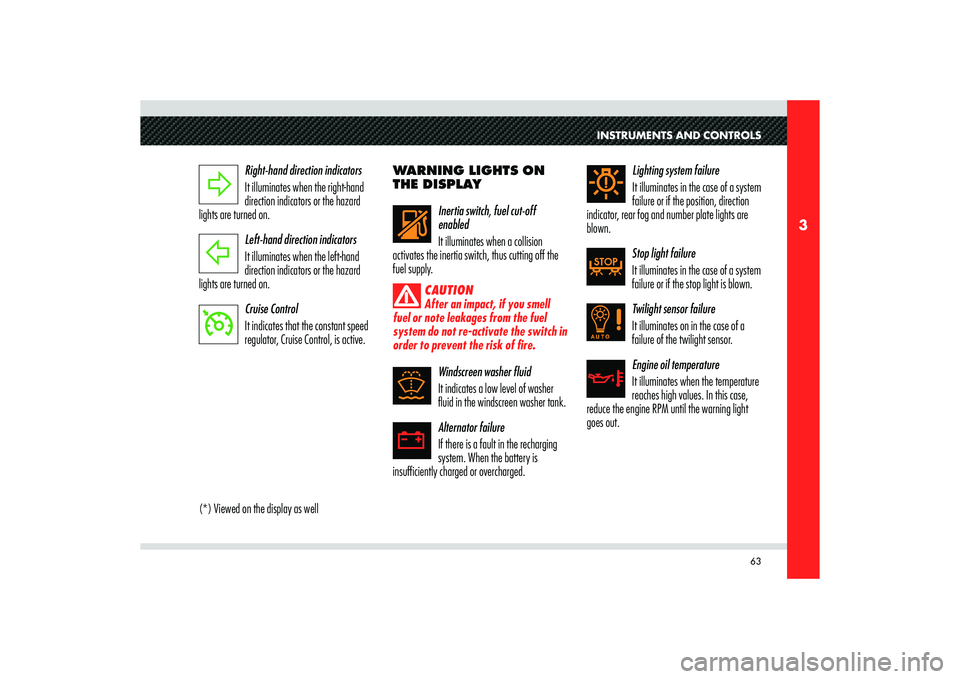
63
3
INSTRUMENTS AND CONTROLS
Right-hand direction indicators
It illuminates when the right-hand
direction indicators or the hazard
lights are turned on.
Left-hand direction indicators
It illuminates when the left-hand
direction indicators or the hazard
lights are turned on.
Cruise Control
It indicates that the constant speed
regulator, Cruise Control, is active.
(*) Viewed on the display as wellWARNING LIGHTS ON
THE DISPLAY
Inertia switch, fuel cut-off
enabled
It illuminates when a collision
activates the inertia switch, thus cutting off the
fuel supply.
CAUTION
After an impact, if you smell
fuel or note leakages from the fuel
system do not re-activate the switch in
order to prevent the risk of fire.
Windscreen washer fluid
It indicates a low level of washer
fluid in the windscreen washer tank.
Alternator failure
If there is a fault in the recharging
system. When the battery is
insufficiently charged or overcharged. Lighting system failure
It illuminates in the case of a system
failure or if the position, direction
indicator, rear fog and number plate lights are
blown.
Stop light failure
It illuminates in the case of a system
failure or if the stop light is blown.
Twilight sensor failure
It illuminates on in the case of a
failure of the twilight sensor.
Engine oil temperature
It illuminates when the temperature
reaches high values. In this case,
reduce the engine RPM until the warning light
goes out.
Page 67 of 223
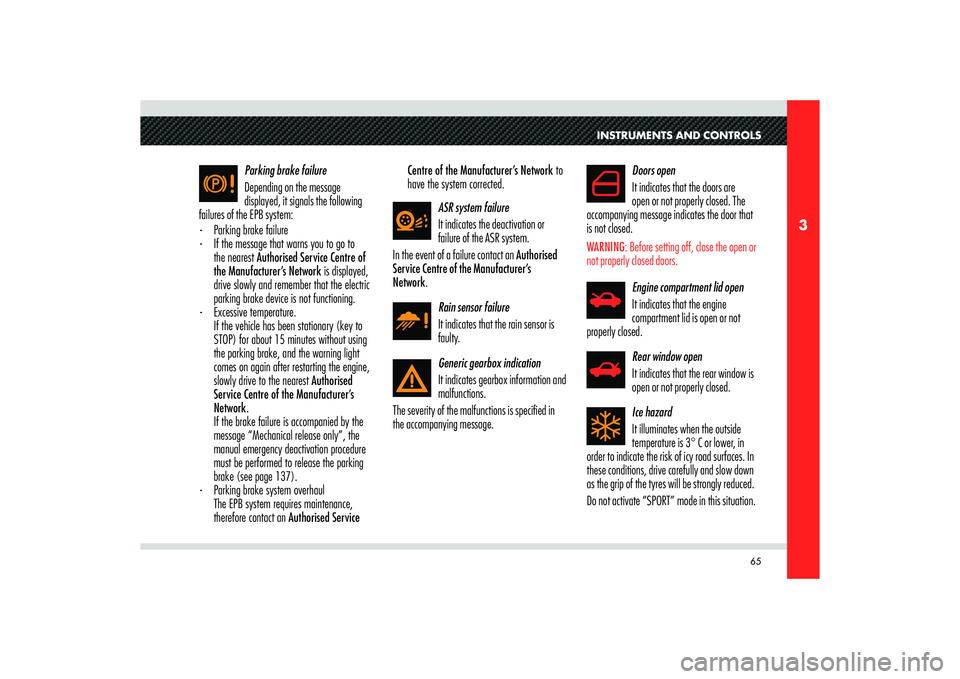
65
3
INSTRUMENTS AND CONTROLS
Parking brake failure
Depending on the message
displayed, it signals the following
failures of the EPB system:
- Parking brake failure
- If the message that warns you to go to
the nearest Authorised Service Centre of
the Manufacturer’s Network is displayed,
drive slowly and remember that the electric
parking brake device is not functioning.
- Excessive temperature.
If the vehicle has been stationary (key to
STOP) for about 15 minutes without using
the parking brake, and the warning light
comes on again after restarting the engine,
slowly drive to the nearest Authorised
Service Centre of the Manufacturer’s
Network.
If the brake failure is accompanied by the
message “Mechanical release only”, the
manual emergency deactivation procedure
must be performed to release the parking
brake (see page 137).
- Parking brake system overhaul
The EPB system requires maintenance,
therefore contact an Authorised Service Centre of the Manufacturer’s Network to
have the system corrected.
ASR system failure
It indicates the deactivation or
failure of the ASR system.
In the event of a failure contact an Authorised
Service Centre of the Manufacturer’s
Network.
Rain sensor failure
It indicates that the rain sensor is
faulty.
Generic gearbox indication
It indicates gearbox information and
malfunctions.
The severity of the malfunctions is specified in
the accompanying message.Doors open
It indicates that the doors are
open or not properly closed. The
accompanying message indicates the door that
is not closed.
WARNING: Before setting off, close the open or
not properly closed doors.
Engine compartment lid open
It indicates that the engine
compartment lid is open or not
properly closed.
Rear window open
It indicates that the rear window is
open or not properly closed.
Ice hazard
It illuminates when the outside
temperature is 3° C or lower, in
order to indicate the risk of icy road surfaces. In
these conditions, drive carefully and slow down
as the grip of the tyres will be strongly reduced.
Do not activate “SPORT” mode in this situation.
Page 69 of 223
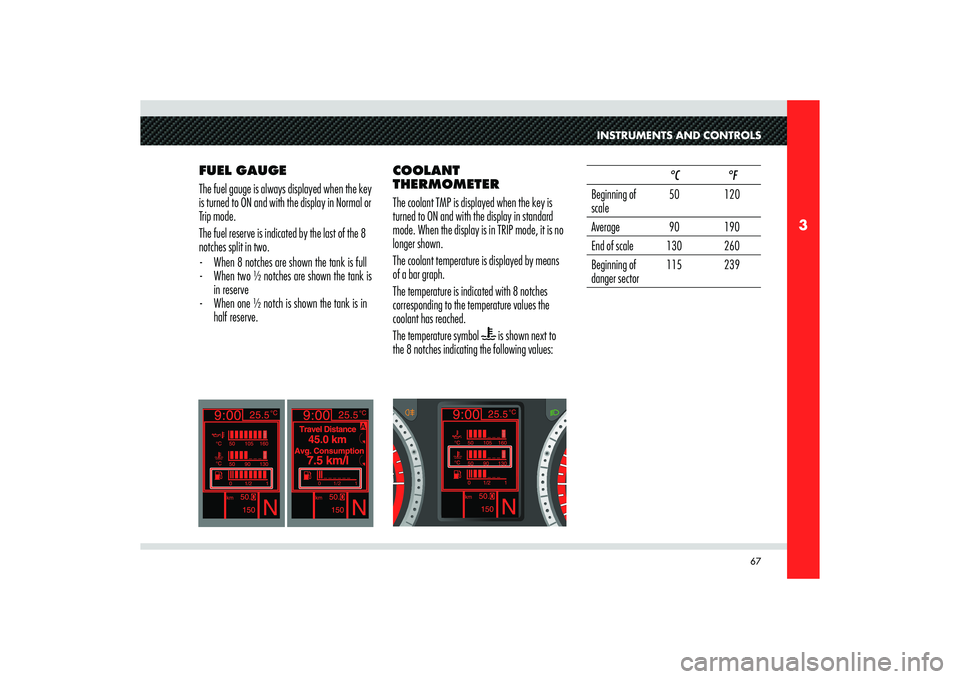
67
3
°C
50
°C90 130
50 90 130
0 1/2 1
INSTRUMENTS AND CONTROLS
FUEL GAUGE
The fuel gauge is always displayed when the key
is turned to ON and with the display in Normal or
Trip mode.
The fuel reserve is indicated by the last of the 8
notches split in two.
- When 8 notches are shown the tank is full
- When two � notches are shown the tank is
in reserve
- When one � notch is shown the tank is in
half reserve.COOLANT
THERMOMETER
The coolant TMP is displayed when the key is
turned to ON and with the display in standard
mode. When the display is in TRIP mode, it is no
longer shown.
The coolant temperature is displayed by means
of a bar graph.
The temperature is indicated with 8 notches
corresponding to the temperature values the
coolant has reached.
The temperature symbol
is shown next to
the 8 notches indicating the following values:°C °F
Beginning of
scale50 120
Average 90 190
End of scale 130 260
Beginning of
danger sector 115 239
Page 70 of 223
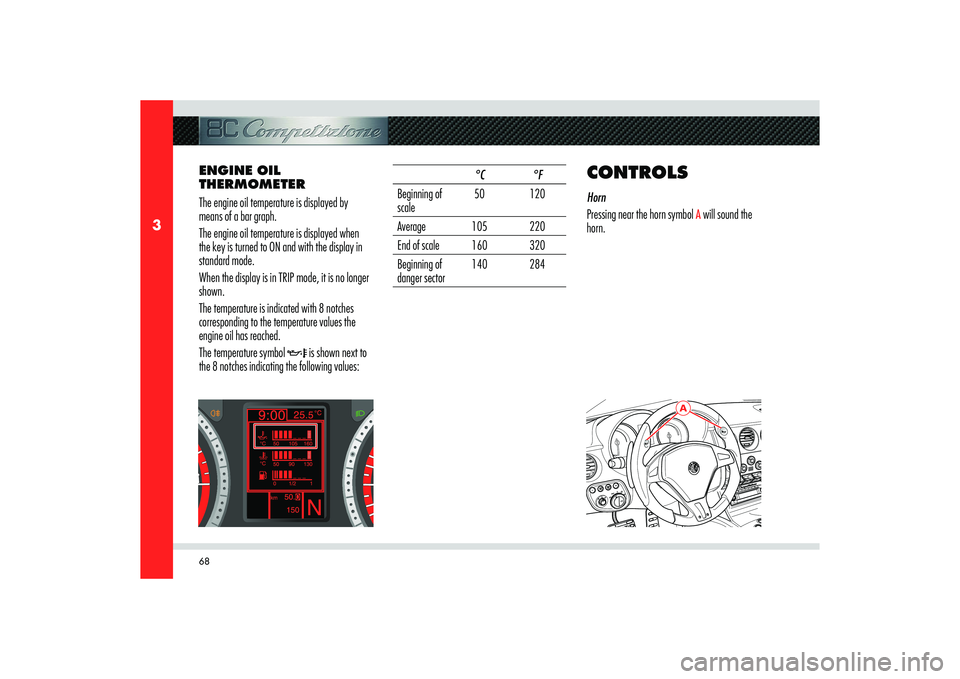
68
3
A
ENGINE OIL
THERMOMETER
The engine oil temperature is displayed by
means of a bar graph.
The engine oil temperature is displayed when
the key is turned to ON and with the display in
standard mode.
When the display is in TRIP mode, it is no longer
shown.
The temperature is indicated with 8 notches
corresponding to the temperature values the
engine oil has reached.
The temperature symbol
is shown next to
the 8 notches indicating the following values:°C °F
Beginning of
scale50 120
Average 105 220
End of scale 160 320
Beginning of
danger sector 140 284
CONTROLS Horn
Pressing near the horn symbol
A will sound the
horn.
Page 72 of 223
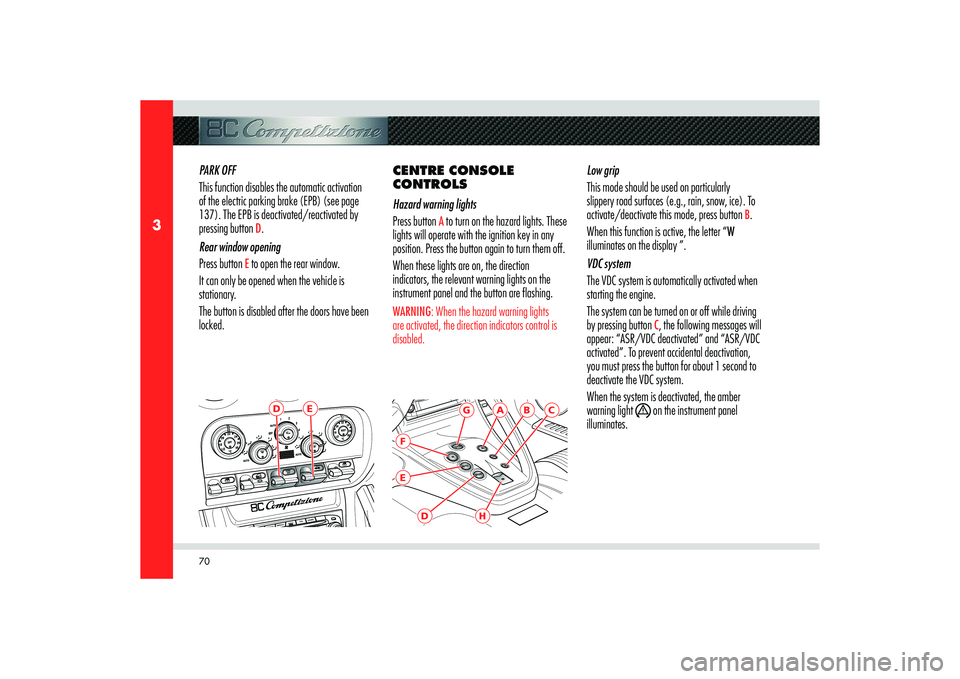
70
3
E
D
B
A
G
FE
D
H
C
PARK OFF
This function disables the automatic activation
of the electric parking brake (EPB) (see page
137). The EPB is deactivated/reactivated by
pressing button
D.
Rear window opening
Press button
E to open the rear window.
It can only be opened when the vehicle is
stationary.
The button is disabled after the doors have been
locked.CENTRE CONSOLE
CONTROLS
Hazard warning lights
Press button
A to turn on the hazard lights. These
lights will operate with the ignition key in any
position. Press the button again to turn them off.
When these lights are on, the direction
indicators, the relevant warning lights on the
instrument panel and the button are flashing.
WARNING: When the hazard warning lights
are activated, the direction indicators control is
disabled.
Low grip
This mode should be used on particularly
slippery road surfaces (e.g., rain, snow, ice). To
activate/deactivate this mode, press button
B.
When this function is active, the letter “W
illuminates on the display ”.
VDC system
The VDC system is automatically activated when
starting the engine.
The system can be turned on or off while driving
by pressing button
C, the following messages will
appear: “ASR/VDC deactivated” and “ASR/VDC
activated”. To prevent accidental deactivation,
you must press the button for about 1 second to
deactivate the VDC system.
When the system is deactivated, the amber
warning light
on the instrument panel
illuminates.
Page 73 of 223
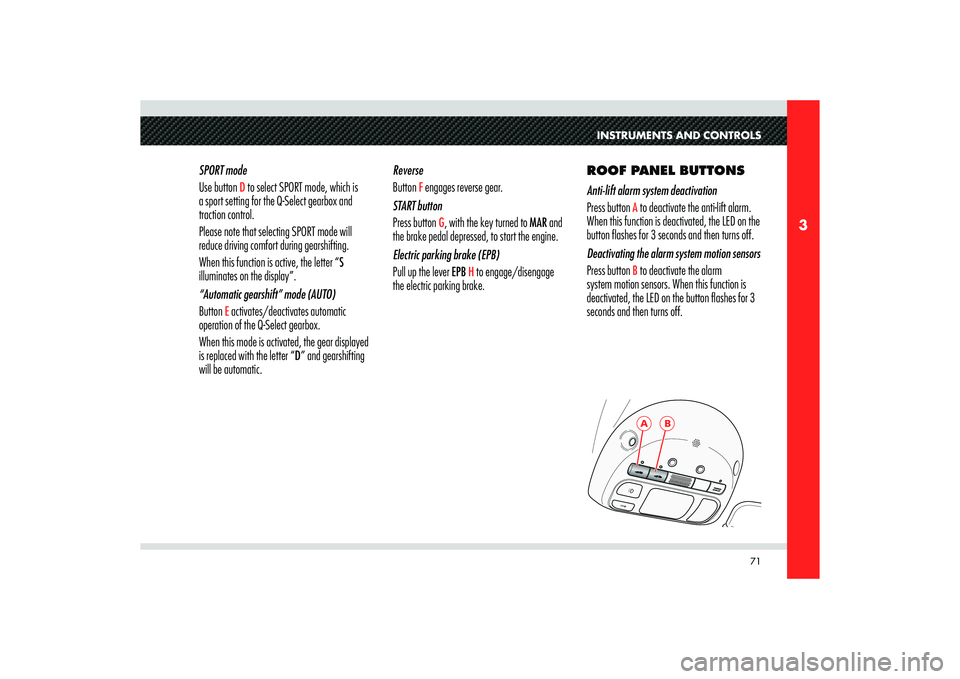
71
3
A
B
INSTRUMENTS AND CONTROLS
SPORT mode
Use button
D to select SPORT mode, which is
a sport setting for the Q-Select gearbox and
traction control.
Please note that selecting SPORT mode will
reduce driving comfort during gearshifting.
When this function is active, the letter “S
illuminates on the display”.
“Automatic gearshift” mode (AUTO)
Button
E activates/deactivates automatic
operation of the Q-Select gearbox.
When this mode is activated, the gear displayed
is replaced with the letter “D” and gearshifting
will be automatic.Reverse
Button
F engages reverse gear.
START button
Press button
G, with the key turned to MAR and
the brake pedal depressed, to start the engine.
Electric parking brake (EPB)
Pull up the lever EPB
H to engage/disengage
the electric parking brake.ROOF PANEL BUTTONS
Anti-lift alarm system deactivation
Press button
A to deactivate the anti-lift alarm.
When this function is deactivated, the LED on the
button flashes for 3 seconds and then turns off.
Deactivating the alarm system motion sensors
Press button B to deactivate the alarm
system motion sensors. When this function is
deactivated, the LED on the button flashes for 3
seconds and then turns off.
Page 81 of 223
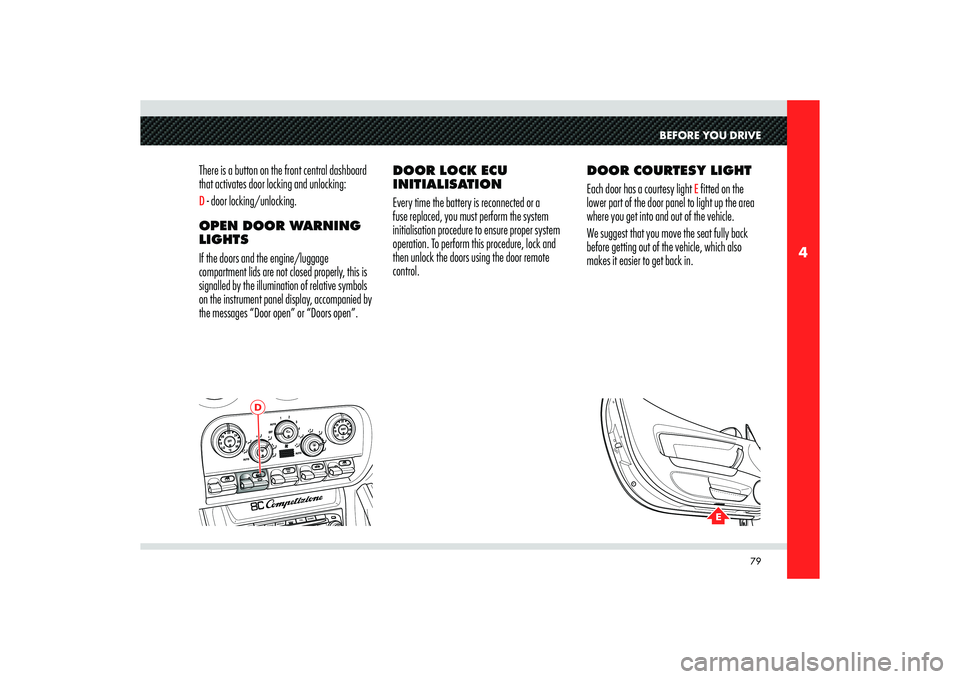
79
4
D
E
BEFORE YOU DRIVE
There is a button on the front central dashboard
that activates door locking and unlocking:D - door locking/unlocking.
OPEN DOOR WARNING
LIGHTS
If the doors and the engine/luggage
compartment lids are not closed properly, this is
signalled by the illumination of relative symbols
on the instrument panel display, accompanied by
the messages “Door open” or “Doors open”.DOOR LOCK ECU
INITIALISATION
Every time the battery is reconnected or a
fuse replaced, you must perform the system
initialisation procedure to ensure proper system
operation. To perform this procedure, lock and
then unlock the doors using the door remote
control.DOOR COURTESY LIGHT
Each door has a courtesy light
E fitted on the
lower part of the door panel to light up the area
where you get into and out of the vehicle.
We suggest that you move the seat fully back
before getting out of the vehicle, which also
makes it easier to get back in.
Page 86 of 223
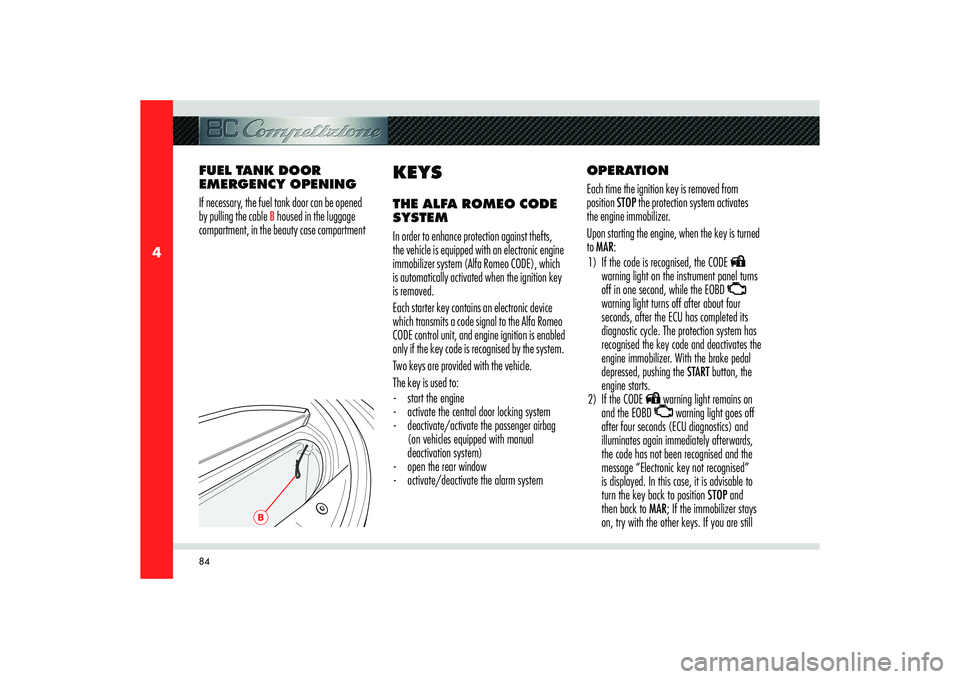
84
4
B
OPERATION
Each time the ignition key is removed from
position STOP the protection system activates
the engine immobilizer.
Upon starting the engine, when the key is turned
to MAR:
1) If the code is recognised, the CODE
warning light on the instrument panel turns
off in one second, while the EOBD
warning light turns off after about four
seconds, after the ECU has completed its
diagnostic cycle. The protection system has
recognised the key code and deactivates the
engine immobilizer. With the brake pedal
depressed, pushing the START button, the
engine starts.
2) If the CODE warning light remains on
and the EOBD warning light goes off
after four seconds (ECU diagnostics) and
illuminates again immediately afterwards,
the code has not been recognised and the
message “Electronic key not recognised”
is displayed. In this case, it is advisable to
turn the key back to position STOP and
then back to MAR; If the immobilizer stays
on, try with the other keys. If you are still FUEL TANK DOOR
EMERGENCY OPENING
If necessary, the fuel tank door can be opened
by pulling the cable
B housed in the luggage
compartment, in the beauty case compartment
KEYSTHE ALFA ROMEO CODE
SYSTEM
In order to enhance protection against thefts,
the vehicle is equipped with an electronic engine
immobilizer system (Alfa Romeo CODE), which
is automatically activated when the ignition key
is removed.
Each starter key contains an electronic device
which transmits a code signal to the Alfa Romeo
CODE control unit, and engine ignition is enabled
only if the key code is recognised by the system.
Two keys are provided with the vehicle.
The key is used to:
- start the engine
- activate the central door locking system
- deactivate/activate the passenger airbag
(on vehicles equipped with manual
deactivation system)
- open the rear window
- activate/deactivate the alarm system